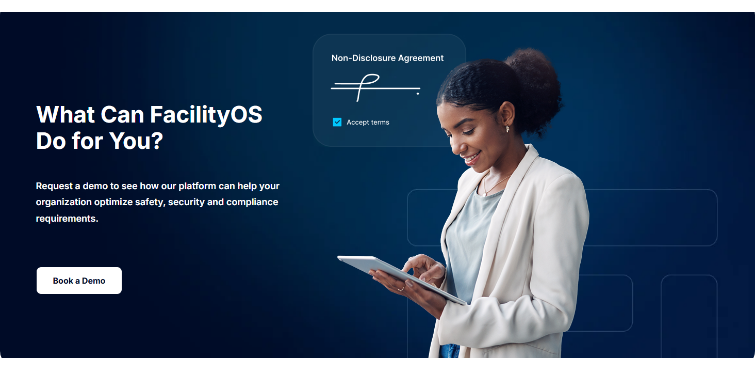When Do You Need an Enterprise Visitor Management System?
Visitor management (VMS) is a critical function at every location, regardless of visitor volume. Even low-traffic sites require secure, auditable, and professional check-in processes. At the enterprise level, however, visitor management takes on a broader, more strategic role. With multiple facilities, diverse compliance obligations, and the need for centralized visibility and control, enterprises require a solution that can scale effectively across the entire organization.
An enterprise visitor management system is purpose-built for organizations with distributed operations and heightened security or compliance requirements. It delivers the scalability, oversight, and consistency needed to manage visitors across all sites, while aligning with both internal policies and external regulatory standards.
This article examines what distinguishes enterprise-grade systems, when they should be considered, and how to identify the right solution for your operational needs.
What is an Enterprise Visitor Management System?
An enterprise visitor management system is a digital solution for large organizations that automates the process of managing and monitoring visitors, access across one or multiple facilities. When optimized, it aids in ensuring security, maintaining regulatory compliance, and enhancing the overall visitor experience for guests, contractors, and employees.
Enterprise systems are built to enforce consistent visitor policies at scale. Beyond keeping track of who is on-site, they verify visitor identity, screen against watchlists, record time-stamped entries and exits, and store visitor data in a secure, searchable database. They also give administrators oversight across all sites, ensuring uniform compliance and immediate access to visitor logs.
For manufacturers with restricted production areas, distribution centers with strict access windows, or government contractors with export controls like ITAR, managing visitors in this way is not optional, it’s essential to maintaining operational integrity and avoiding compliance risks.
Key Features of Enterprise Visitor Management Systems
Rather than relying on fragmented processes or multiple siloed systems, enterprise VMS solutions are distinguished by a suite of advanced capabilities designed to support operations at scale. Here are some core capabilities to look for:
- Centralized oversight across all locations: Manage visitor policies, view activity, and generate reports from a single dashboard, no matter how many sites you operate.
- Pre-registration: Let visitors submit their information ahead of time to speed up entry, reduce front desk workload, and prevent bottlenecks during peak hours.
- Touchless check-in: Enable a fast, hygienic check-in experience by allowing visitors to sign in using their own devices, no need to touch shared surfaces.
- Instant host notifications: Automatically notify employees the moment their visitor arrives, minimizing wait times and keeping everyone informed.
- Watchlist screening & access control integration: Protect your facilities by automatically screening visitors against internal or external watchlists and integrating with access control systems.
- Audit-ready visitor records: Keep detailed, searchable logs of every visitor to support audits, investigations, and compliance reviews.
- Compliance support built in: Help your team meet regulatory requirements like GDPR, ITAR, and OSHA with features that enable audit-ready visitor logs, customizable sign-in flows, and automated data retention policies — all designed for enterprise-grade compliance.
- Seamless integrations: Sync effortlessly with the tools your teams rely on every day through open architecture and third-party system compatibility. Integrations with platforms like Okta, Outlook, Salesforce, Microsoft, and Cisco (and more) ensure flexibility, continuity, and minimal disruption to existing workflows.
- Emergency evacuation support: In an emergency, integrating visitor management with an emergency response tool ensures you know exactly who’s on-site, including visitors and contractors, so you can respond confidently. For example, FacilityOS’s VisitorOS and EmergencyOS work together on the same platform to provide real-time visibility and coordinated response during critical events.
- Branded visitor experience: Reinforce your corporate identity with customized badges, kiosks, and check-in screens that look and feel professional.
Functionality isn’t just about convenience. There is a direct impact on compliance and security, which we’ll explore next.
Compliance & Security Considerations
For enterprises, particularly those in regulated or security-sensitive industries, visitor management goes beyond basic check-in. It helps safeguard sensitive information by ensuring oversight and accountability for all visitors and contractors on-site. Whether you operate in manufacturing, logistics, government, or healthcare, your visitor management process should be equipped to support:
- Data privacy laws: Ensure that personally identifiable information (PII) from visitors is securely collected and handled in compliance with laws like GDPR or CCPA.
- Industry-specific standards: Comply with export control regulations such as ITAR, workplace safety mandates like OSHA, or food safety protocols in regulated environments.
- Cybersecurity requirements: Safeguard visitor data against breaches with secure storage and transmission practices.
A proper enterprise visitor management system provides these safeguards while reducing manual recordkeeping and human error.
When to Consider an Enterprise Visitor Management System

Here are clear signs that your organization needs the support of an enterprise visitor management system:
- High and/or low visitor volume: Your locations either see hundreds of visitors or only a few daily, regardless of volume relying on manual processes or limited digital tools can be slow, error-prone, and inadequate for security.
- One site or multiple facilities: Whether you operate in more than one location or have just one site, the need for consistent visitor policies, centralized visibility, and consolidated reporting is the same.
- Regulatory exposure: You are subject to audits or must demonstrate compliance with internal and industry regulations.
- Integration needs: You require visitor data to connect with access control, HR, ERP, or watchlist systems.
- Diverse visitor types: You regularly handle employees, contractors, vendors, and/or VIPs, each needing a unique workflow.
- Planned growth: Your operations are expanding, and you need a solution that scales to new sites and more visitors without disruption.
Whether you rely on manual processes or a visitor management system that is failing to scale or exposing you to risk, it’s time to evaluate an enterprise-grade system.
Real-Life Transformations: Enterprise VMS In Action
Organizations that have implemented an enterprise visitor management system have seen measurable improvements in compliance, efficiency, and security.
SMTC, a global electronics manufacturer, operates within multiple industries with strict regulatory requirements and a high volume of visitors across multiple facilities. They needed a consistent way to capture visitor credentials, maintain accurate records, and streamline their visitor management processes. By deploying FacilityOS’s enterprise visitor management system, VisitorOS, SMTC standardized visitor processes across all locations, improved their ability to demonstrate compliance during audits, reduced manual recordkeeping, and made check-ins faster and more reliable.
Maple Lodge Farms, Canada’s largest chicken processor, needs to maintain the highest food safety standards. Every visitor to their production facilities must meet strict hygiene and access protocols. Relying on manual sign-ins created risks and inefficiencies. After adopting FacilityOS’s enterprise visitor management system, VisitorOS, Maple Lodge Farms automated visitor check-ins, and created clear, auditable records that support regulatory inspections. They also improved throughput at entry points, even during their busiest times.
These examples show how enterprise visitor management, like FacilityOS’s VisitorOS, becomes an integral part of a larger operational and compliance strategy. With the right system in place, organizations can protect their facilities, simplify audits, and provide a more professional experience for everyone who enters their facilities.
Results at a Glance: The Impact of Enterprise Visitor Management
SMTC
|
Maple Lodge Farms
|
Choosing the Right Solution
Not every visitor management system is built to handle enterprise-level demands. When looking at solutions, evaluate:
- Scalability: Can it grow with your organization?
- Reporting: Does it provide centralized, real-time oversight of all facilities?
- Integration capabilities: Can it integrate with the systems you already rely on?
- Customization: Are workflows configurable to accommodate different visitor types and site requirements?
- Data Security: How is visitor data protected, and does it align with privacy and cybersecurity standards?
- User experience: Is it intuitive for both admins and visitors?
- Compliance: Will it deliver actionable reports for internal use and external audits?
- Costs: What are the upfront and ongoing costs, and are they predictable?
By asking these questions, you can identify a solution that meets today’s needs and supports future growth.
Conclusion

For enterprise organizations, visitor management is a critical component of maintaining security, compliance, and operational continuity. Basic sign-in sheets and entry-level tools are not designed to handle the scale and complexity of your operations.
An enterprise visitor management system gives you the control and visibility you need to succeed at scale.
Ready to take the next step? Request a demo and discover how VisitorOS powers secure, scalable visitor management for enterprise organizations.
Stay updated with industry insights, success stories, and more by following us on social media for the latest FacilityOS content.
Stay updated with industry insights, success stories, and more by following us on social media for the latest FacilityOS content.
Table of Contents
Peter Friesen




 Follow us on Facebook
Follow us on Facebook  Follow us on X
Follow us on X
 Follow us on LinkedIn
Follow us on LinkedIn